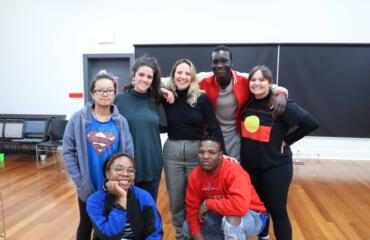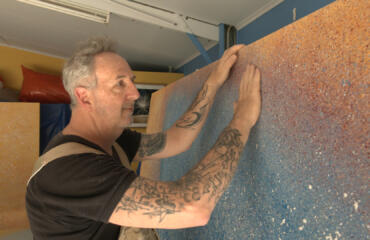
Some films take longer to reveal themselves than others. You sit in the dark and watch the screen and wait for what you’re watching to build, to start having impact.
Often the film ends, the credits start to roll and you’re still waiting. Very occasionally, it is only when they roll and not a moment sooner that the impact of what you have watched crystallises.
So it is with The Tribe (Plemya). Ukrainian director Myroslav Slaboshpytskiy’s incredibly bleak film slowly, ever more horrifically, reveals itself over a grueling two hours. It is a deeply disturbing work of art that is far more than the sum of its already notable parts.
These parts are much discussed. The film contains no verbal dialogue. Rather, the main characters, teenagers at a boarding school in an economically depressed town, communicate in un-subtitled sign language. There is also no music, just the sounds of the characters’ environments.
You might be tricked, as I was initially, into thinking that these two innovations are the keys to understanding The Tribe. It is a mistaken impression that only amplifies the impact of the film once it has ended.

To give an example: there is the scene, about halfway through, where a deaf teenager is run over by a truck he cannot hear. The audience hears it reversing. The audience watches it slowly, inevitably, run over the boy. This is a shocking moment, but also explainable by the two innovations of the film. It seems to confirm that what Slaboshpytskiy is doing here is taking a central idea, deaf teenagers in a violent environment, and taking this idea to self-consciously shocking conclusions.
This would be provocative and interesting enough, were it not for the fact that a teenager being run over by a reversing truck is barely the beginning of the horrors depicted in this film. It gets bleaker. Far bleaker. The depth of depravity depicted, combined with an absence of music directing you how to respond, mean you cannot really process anything until the movie is done.
The kid quickly joins a gang of teenagers, based in one hypnotically long corridor of the boarding house. They traffic both drugs and girls. We’ve left the town behind and entered a violent Narnia. For the rest of the movie the world beyond this gang is barely glimpsed. Nobody intervenes.
A major hint that there is more going on here than just a filmmaker provoking for the hell of it is embedded within the film’s narrative structure. Perversely, The Tribe is structured in a similar way to a fairy tale.
It begins with a deaf teenage boy at a bus stop, asking a stranger for directions in writing. He follows the them and reaches a school. He briefly meets the principal before being taken under the wing of another student. From this moment on all of the film’s authority figures vanish. The kid quickly joins a gang of teenagers, based in one hypnotically long corridor of the boarding house. They traffic both drugs and girls. We’ve left the town behind and entered a violent Narnia. For the rest of the movie the world beyond this gang is barely glimpsed. Nobody intervenes.
The Tribe is a silent-ish film in a way that 2011’s The Artist is not. Whereas that film eschewed dialogue for the sole purpose of demonstrating that you can tell an entertaining story without sound, here the lack of dialogue is but one of several things going on, none of which is assuming as its primary purpose to entertain.
Over the first half of The Tribe, Slaboshpytskiy plays with the visual novelty of actors signing at each other, seemingly acutely aware that this novelty will inevitably wear off. And so it does, but not before some truly compelling sequences.
In one scene, a crowd surrounds two teenagers fighting and starts signing furiously at one another. Their bodies are almost perfectly still but their arms and hands are busy and come to dominate the visual language of the scene.
Apart from the fact that these characters seem to spend all their time fighting and attacking people and pimping out girls to truck drivers, they’re doing so in an almost dystopian urban environment. The burned out shell of a truck decorates the bus stop. One fight takes place in a room knee-deep in rubbish. Teenagers sit on derelict playground equipment. This is a depressing vision of Ukraine.

As you adjust to The Tribe’s visual novelty, it is Slaboshpytskiy’s use of sound that provocatively lingers. One tortuous scene is a real-time depiction of a teenager having a backroom abortion. We hear each step of the process. The quiet, steady burn of an oven stovetop that is sterilising the tools. The snapping of latex gloves. Heavy breathing transforming into painful wailing. The metallic scraping of instruments.
You can look away but you can’t close your ears.
“This is not a film for deaf people,” Myroslav Slaboshpytskiy has said, and it’s true that none of this would work quite so well if the audience either understood Ukrainian sign language or could not hear the film’s sounds. This feels like The Tribe’s greatest provocation: it prohibits from its own impact the very deaf people whom it portrays.
► 4 stars
► The Tribe (Plemya) is screening in a limited run at The Australian Centre for the Moving Image until May 10. It will also appear at the Sydney Film Festival in June.


